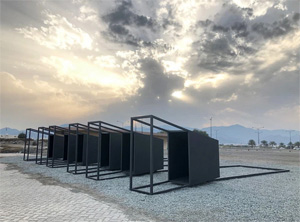8.14.24 — Go with the Flow
To pick up from last time, most of the seventy-one contributors to the 2024 Whitney Biennial have a room to themselves. It gives them space like a solo exhibition, yet it also turns almost everything into an installation.
Rooms to the side for new media punctuate the flow. Isaac Julien begins his with a wall of mirrors, before a quiet narrative set on several screens. It tracks a silent conversation between past and present African American sculpture and an intellectual founder of the Harlem Renaissance. One might have wandered into a maze, where the only way out is to sit still. 
Speaking of permeability, they also bleed into one another. Each floor of the 2022 Biennial had its own character. This one has instead a continuous flow. One can step from Suzanne Jackson, whose layered paint and gel become their own armature, to a different kind of hanging, by ektor garcia in cotton and lace. It is only a step from there to tatami mats and film stained with color by Lotus L. Kang, like Mark Rothko set free from the walls. Karyn Olivier leaves more clothing in a circle on the floor, as a pile of trash or a place of rest.
One might turn from testimonies to abortion by Carmen Winant, more than twenty-five hundred of them, to pregnancy and motherhood for Julia Phillips. You may remember her ceramic hips when you come to body casts from Jes Fan or a bronze liver from K. R. M. Mooney. Nor is it far from Westin’s smoked glass to a Lakota tent from Cannupa Hanska Luger—it, too, inverted and suspended overhead. It is Transportable Intergenerational Protection Infrastructure, because her entire “world is upside down.” Draped pillars from Dala Nasser in Lebanon stand beside four Daughters from Rose B. Simpson in New Mexico. They could be a single cross-cultural installation.
Out on a terrace, Torkwase Dyson arranges massive geometry in black as a “playground.” Tony Smith and Minimalism meet African American art now. A floor above, Kiyan Williams fashions a reproduction of the White House from black soil. It tilts badly, just as Luger’s tipi is inverted. A wall of amber from Eddie Rodolfo Aparicio stands just inside. I mistook them for work of the same artist.
Old media like painting and drawing are rare but worth regarding. Mary Lucier marks a calendar with the many deaths of colleagues and friends. Phillips recovers memory from “conception drawings” in vegetable oil and oil pastel. Mavis Pusey in 1970 took her active geometry from an ever-changing New York, but it looks more like prewar abstraction. Mary Lovelace O’Neal may have been thinking of blackness, but she rides a blue whale in wave upon wave of paint. Jackson is still very much a painter.
If you forget that, you have bought into a stunning but heavy-handed biennial. It has older artists, like Lucier, Jackson, and Harmony Hammond, all born in 1944, and Lovelace O’Neal, born in 1942, although a generation or two goes largely missing along the way. Hammond, too, works between weaving and abstraction, like Minimalism brought to feminist life. Pusey, like Jackson a black artist, died in 2018. You might not know it, though, in a show that wants desperately to be current. Oh, and did I mention politics, for next time I focus on that and and its reliance on light, sound, and video?
Read more, now in a feature-length article on this site.